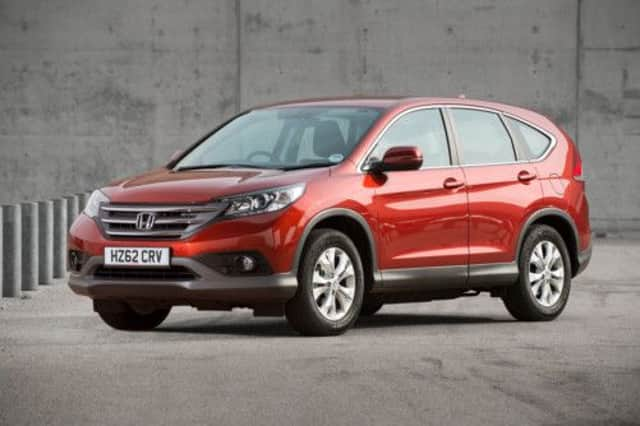Motoring review: Honda CR-V


It was also made in Japan, Taiwan, the Philippines and Thailand. This car was always going to be a big seller. More than five million have been produced.
The fourth generation here is a confident-looking large hatchback SUV, with styling more suited to its crucial markets in North America and China. Swindon makes them for Europe with other buyers supplied from factories in Mexico, Japan, Ontario Canada, Indonesia, Thailand and Ohio in the USA.
Advertisement
Hide AdAs my test ended, though, Honda announced job cuts at Swindon. Its sales had been ahead of the market in Britain but in Europe it was hit by weak overall markets in Italy, Spain and Greece. Half its UK production goes to Europe, where it lost seven per cent of sales last year.
Back to the CR-V. It is, clearly, a serious contender. The new front is dominated by three chromed bars. The sides are fuller and there is what BMW would call a Hofmeister kink on the rearmost side windows. This lightens the visual impact of the roof pillars and adjoining roof. Whether it looks better that way is a moot point and the new face is a debatable advance. It looks bigger but I’d got used to the pouting jaw of the “old” one. It has more character.
The first generation CR-V (1995-2001) is still a common sight, which suggests it enjoys Honda’s build longevity. It also has the more workaday appearance of an estate car at the back. A talking point of this Mk 1 was the lift-up rear window over a swing-out lower section.
These days the CR-V has a full-length tailgate covering a decent load space, deep enough thanks to the provision of a space-save spare rather than a full-size wheel, stored under the boot floor.
This cavernous luggage area will impress buyers, as will the way the rear seats tumble to make the deck long and flat. Pull either a tag on the sear base, or a lever inside the tailgate, and the primed springs do the rest. You have to erect them – by hand – but the springs help rather than hinder the process. My upscale test car also had a powered tailgate, opened using the key fob and closed by tapping a switch on the tailgate’s lip. Such helpmates should not be underestimated.
Nor should the thirst of the petrol engine offered, a 153bhp 2-litre petrol which runs as smoothly as any Honda mill. With front wheel drive (S and SE trim, from £21,395) it is rated at 39.2mpg and 168g/km of CO2. With 4x4 transmission (all four trim grades plus the option of automatic gears) it loses little in economy or CO2 ratings. The 4x4 S and SE models cost £1,100 more than their front-drive partners and this will be one poser for the buyer.
Advertisement
Hide AdIf you do field driving or rutted tracks then the 4x4 will go where the other slithers. If you are worried about snow, then it is the same answer, though for either mud or snow you’d be wise to have bespoke tyres rather than the everyday Michelins fitted to the demo car.
This model was the EX with manual gears, at the top of the CR-V heap at £28,900 plus £500 for black paint, said to be pearlescent (the automatic version is £30,400). It is rated at 37.2mpg and 177g/km and, unusually, the everyday MPG as quoted by the trip computer was not far off – regularly in the mid 30s and reaching 37 miles a gallon on a 250 mile trip, mostly motorway. This, by comparison, was slightly better than achieved in similar use the previous week with a Land Rover Freelander2 automatic with a 187bhp 2.2 diesel.
Advertisement
Hide AdHonda also offers a 148bhp 2.2 diesel for the CR-V. On paper it offers 11 or 12 more mpg than the petrol model with manual gears, with the gain narrowing to 5mpg with automatic gears. The cheapest diesel is in 4x4 S trim at £24,605 – that is £2,110 more than the petrol version. With fuel costing around 40p more a gallon it is another dilemma for the buyer. The diesel gives better acceleration thanks to its torque – in comparison the petrol engine is weak uphill and at times needs flogging through the gears to keep speed uphill. You may want to afford the luxury of diesel power, with prospects of a higher trade-in value.
The EX kit includes accurate and well-timed navigation, leather, the power tailgate, keyless entry, a full length clear roof panel and electrically adjusted driver’s seat with memory settings. Annoyingly, it obligingly slid back when the engine was turned off, making exit and entry easier but needed manually re-setting. I am told this can be obviated by pressing the right buttons on the fob. «
Verdict: Definitely a contender, a handy do-all. In size they fit between Audi’s Q3 and Q5. The length is 15 foot or 4.6 metres.